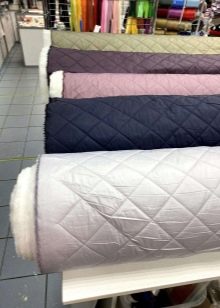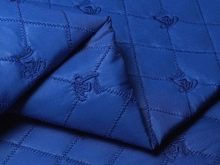All about quilted fabric

Quilted fabric is a multi-layer material in which there will be at least three of these layers. Such fabric has its advantages and disadvantages, varieties and areas of use. And, of course, it requires special care.



What it is?
Usually, 3 layers are combined in quilted fabric: 2 outer layers plus a middle filler. But all the layers are firmly connected to each other. Thanks to this structure, the fabric acquires a convex pattern, and the stitch helps to create this pattern. Hence the name. The composition of the material depends on the functionality. Most often, such fabric is used for the development of clothing and interior textiles.
For the first time, quilted fabric began to be used in ancient China. Then the canvas ended up in Europe and America. The quilted pattern even then began to take shape in geometric shapes, floral and plant patterns, or some kind of fantasy themes. The fabric that will be the base may have a membrane layer or be water-repellent.



Let's see what determines the composition of the material:
- if quilted fabric is used for sewing bedding, then it will be microfiber, cotton, wool, mixed fabric with polyester;
- bedspreads and blankets are also more often sewn from polyester, and also from a mixed fabric with viscose and cotton;
- if outerwear is made, then they use polyester, nylon and, of course, bologna, but the wrong side can be fleece or microfiber.
The fillers are often synthetic winterizer, batting, polyester fabric, bamboo, shervisin, holofiber and thinsulate. And synthetics usually have more advantages, because synthetic filler practically does not absorb moisture and weighs little. It is also hypoallergenic.


Advantages and disadvantages
The main advantage of the fabric is its visual appeal.It is the quilted pattern that creates the charm that people like in jackets and coats, in bedspreads and blankets. In addition, the stitch pattern can be different, sometimes even highly artistic.
What else can be attributed to the pluses of quilted fabric:
- comfort: the materials used are soft, very comfortable to wear;
- lightness: the products are really lightweight;
- good heat protection: little wind blows through quilted clothes;
- breathability: the body breathes under the quilted fabric;
- durability: things do not lose their qualities with each wash, they serve for a long time;
- resistance to sunlight: clothes will not fade in the sun;
- low percentage of elongation: the fabric will not shrink or lose its shape.


By the way, this canvas will not look voluminous, that is, it will not enlarge the figure visually. For those who want to stay elegant and in a quilted coat too, this is important. Finally, working with quilted fabrics is easy: they are easy to cut and easy to sew.
Cons, however, are more often associated with a manufacturing defect. For example, it happens that a manufacturer uses low-quality artificial leather, and then the material may burst at the stitches. Also, the seams can open up if the threads are not of very high quality. Pure cotton threads are also torn. Therefore, threads with polyester in the composition are more preferable. The thicker the layer of insulation, the thicker the thread for quilting should be. If the fabrics are fastened with thermostitch or ultrastep (modern methods of fastening), then even local tissue detachment can become a defect.



Views
The first type is a classic stitch, that is, fabrics are fastened using threads... Then the layers are literally stitched through, the threads form a pattern on top. And this method is good because it is suitable for absolutely all fabrics. Thermo stitch Is a method of bonding synthetic fabrics. The layers are glued together, not stitched together, and this is done using a press with heated heads. Ultrastep - this is actually a method when bonding is carried out with ultrasound, which heats up individual zones on the tissue. Again, this method is suitable only for those fabrics in which the percentage of synthetics is at least 30.


Let's see what kind of quilted fabrics are for their intended purpose.
- Lining... They can be made of polycotton, satin or coarse calico, and the inner layer is synthetic winterizer or batting (possibly other insulation). Outerwear for children and adults is often made using these fabrics. The material retains heat well, while the skin breathes.
- Quilted leather. Usually they are quilted to leatherette (or eco-leather). Both thermal stitch and thread stitch can be used. Outerwear and accessories are sewn from this material.
- Quilted raincoats. The top layer of the fabric is either polyester or bologna, while the inner layer is usually fleece or polar fleece. The filler is a synthetic winterizer. If this is a spring-summer series, there may not be a middle layer. Raincoats and windbreakers are what are made of such fabric.
- Quilted jackets... Synthetics are used on the front side, fleece, microfiber and cotton are taken on the wrong side. The fillers are holofiber and synthetic winterizer, possibly artificial fur. Clothes for children and adults are sewn from this material.
- Knitted... They are made of cotton, which is combined with spandex or polyester, and the inner layer will be a synthetic winterizer. Such a thin and soft material is plastic, it fits well on human skin, it is pleasant to it. Skirts and dresses, jackets, sweatshirts and bombers, windbreakers are made of it.
Three-layer materials can be dyed or printed. If this is home textiles, which are sometimes double-sided functional, then the top layer is often jacquard or even embroidery, patchwork and its skillful imitation.

Applications
It seems that the biggest area where quilts are needed is in outerwear. Indeed, this is a very good and demanded option for jackets.But they also make cool things from quilted eco-leather, for example: from belts to bags, beautiful hats.
Knitwear with a stitch will be an excellent basis not only for sportswear, but also for cozy household items.


Home quilted textiles are already just a luxury for modern democratic interior styles.... He often repeats embroidery or patchwork, that is, expensive handwork. And it imitates, I must say, very realistic. For bedspreads, blankets, mattresses, quilted fabric is used more and more often. In the interior of country, provence, shabby chic, boho, such products will look very convincing.


Care rules
Of course, when purchasing a thing, you always need to look at the designations on the label. This information is usually enough to understand on which mode to wash the product, at what temperature to iron, etc.
General recommendations are as follows.
- The water temperature during washing should not be higher than 40 degrees for synthetics and 30 degrees for natural fabrics. If it is, for example, a woolen blanket, it must be washed in a special mode.
- Spinning in a machine wash is always a risk, and for quilted fabrics too. Therefore, you need to set the mode with low speed. If washing by hand, you need to twist things without much effort.
- Drying should be away from batteries and heating appliances... When drying bedspreads or clothes, there must be good ventilation in the room.
- If this is outerwear, then store it by hanging it on a hanger.... If these are bedspreads and blankets, then they need special covers for storage. And if it is a quilted wool fabric, it must be treated with moth repellent.

Not only clothes are made from this fabric. For example, soft backpacks have recently become fashionable, the quilted pattern on which is the main "highlight" of the thing. They can also be washed on the delicate cycle and then turned inside out and dried naturally.
If the quilt is washed at a high power setting, the stitches may separate. And this is the main problem that happens to such things during operation. Therefore, when choosing a product, you need to ask what threads are used, you can ask to see the quality certificate.
The same natural cotton is not a compliment at all, but an indicator of the vulnerability of stitches.









